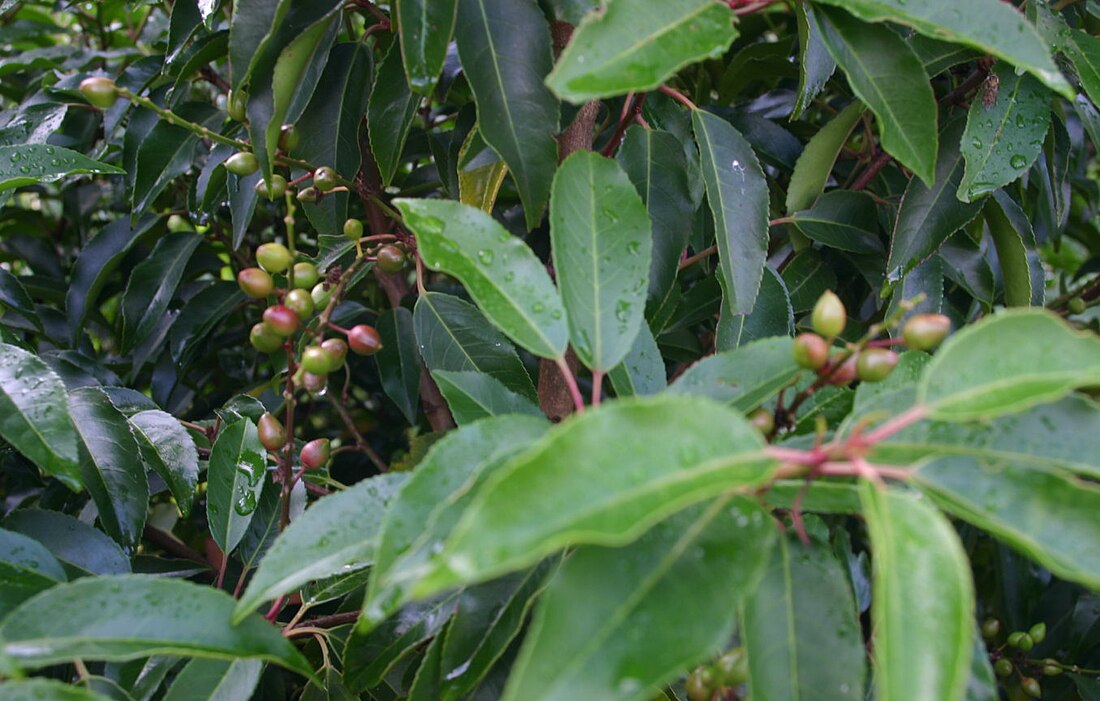Top Qs
Timeline
Chat
Perspective
Prunus lusitanica
Species of flowering plant From Wikipedia, the free encyclopedia
Remove ads
Prunus lusitanica, the Portuguese laurel cherry[4] or Portugal laurel,[5] is a species of flowering plant in the rose family Rosaceae, native to the Iberian Peninsula, Morocco, the Macaronesian archipelagos, and the French Basque Country.[6][7][8]
The split between the subspecies (subsp. azorica, hixa, and lusitanica) is dated around the Pliocene.[9]
Remove ads
Description
Prunus lusitanica is an evergreen shrub or small tree growing to 3-8m tall (though it can reach 15-20m in cultivation).[10][11][12][13] The bark is smooth and dark-grey.[10] The leaves are alternate, oval, 7–15 cm long and 3–5 cm broad,[10] with an acute apex and a dentate margin, glossy dark green above, lighter below.[12] They superficially resemble those of the bay laurel, which accounts for its often being mistaken for one.
The flowers are small (10–15 mm diameter) with five small white petals; they are produced on erect or spreading racemes 15–25 cm long in late spring. The fruit is a small cherry-like drupe 8–13 mm in diameter, green or reddish green at first, turning dark purple or black when ripe in late summer or early autumn.[10][14]
Remove ads
Distribution and habitat


It occurs in the western Mediterranean Basin, France, Spain, and Portugal, and Macaronesia, Azores, Canary Islands and Madeira.
Prunus lusitanica is rare in the wild, found mainly along mountain streams, preferring sunshine and moist but well-drained soils. It is moderately drought-tolerant. It reproduces either sexually (the most successful method) or asexually by cloning from shoots.[15]
Remove ads
Name
The species was first scientifically described by Linnaeus in Species Plantarum in 1753. Its specific epithet lusitanica means "of Lusitania", referring to the Roman name for Portugal.[16]
Subspecies
Three subspecies are accepted:[3]
- Prunus lusitanica subsp. lusitanica. Iberian Peninsula, South-West France, and north Morocco.
- Prunus lusitanica subsp. azorica (Mouill.) Franco. Azores.[17]
- Prunus lusitanica subsp. hixa (Willd.) Franco. Canary Islands and Madeira.
Cultivation
Prunus lusitanica is grown as an ornamental shrub and is widely planted as a hedge and for screening in gardens and parks. It is introduced and locally naturalised in the temperate zone in northern France, Great Britain, Ireland, New Zealand, Western Canada- including the southern BC Mainland and Vancouver Island From Victoria Up Island through the Cowichan, Nanaimo and Parksville as well as the western United States in California, Oregon and Washington State.[citation needed]
Similar to its relative Prunus laurocerasus, P. lusitanica has been recognized by some botanists and land managers in both western Washington and Oregon as invasive. It is thought to have spread from cultivated areas into natural areas by birds who consume the fruit and then defecate the seeds away from the source plant.[citation needed]
It has gained the Royal Horticultural Society's Award of Garden Merit.[18]
Remove ads
Toxicity
The leaves of Prunus lusitanica contain cyanide and will release this into the environment if burnt[19] or if crushed.[20] The fruit is somewhat edible if fully ripe, but if it is bitter, it is toxic and should not be eaten.[21]
References
External links
Wikiwand - on
Seamless Wikipedia browsing. On steroids.
Remove ads



